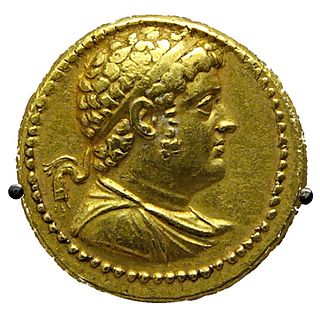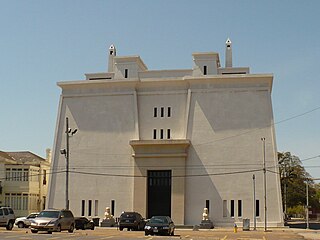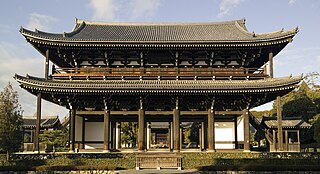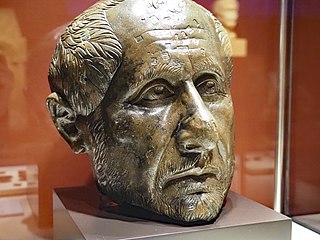
Ptolemy III Euergetes was the third pharaoh of the Ptolemaic dynasty in Egypt from 246 to 222 BC. The Ptolemaic Kingdom reached the height of its military and economic power during his kingship, as initiated by his father Ptolemy II Philadelphus.

Ptolemy IV Philopator was the fourth pharaoh of Ptolemaic Egypt from 221 to 204 BC.
Montu was a falcon-god of war in the ancient Egyptian religion, an embodiment of the conquering vitality of the pharaoh. He was particularly worshipped in Upper Egypt and in the district of Thebes.
[Ramesses II] whom victory was foretold as he came from the womb,
Whom valor was given while in the egg,
Bull firm of heart as he treads the arena,
Godly king going forth like Montu on victory day.
Qift is a city in the Qena Governorate of Egypt about 43 km (27 mi) north of Luxor, situated a little south of latitude 26° north, on the east bank of the Nile. In ancient times its proximity to the Red Sea made it an important trading emporium between India, Punt, Arabia Felix and the North. It was important for nearby gold and quartzite mines in the Eastern Desert, and as a starting point for expeditions to Punt.
The Precinct of Montu, located near Luxor, Egypt, is one of the four main temple enclosures that make up the immense Karnak Temple Complex. It is dedicated to the Egyptian god Montu. The area covers about 20,000 m2. Most monuments are poorly preserved.

Lyrbe was an ancient city and later episcopal see in the Roman province of Pamphylia Prima and is now a titular see.

The Ptolemaic Kingdom or Ptolemaic Empire was an Ancient Greek state based in Egypt during the Hellenistic period. It was founded in 305 BC by the Macedonian general Ptolemy I Soter, a companion of Alexander the Great, and ruled by the Ptolemaic dynasty until the death of Cleopatra VII in 30 BC. Reigning for nearly three centuries, the Ptolemies were the longest and final dynasty of ancient Egypt heralding a distinctly new era for religious syncretism and the blending of a new Greco-Egyptian culture.

The Temple of Ptah is a shrine located within the large Precinct of Amun-Re at Karnak, in Luxor, Egypt. It lies to the north of the main Amun temple, just within the boundary wall. The building was erected by the Pharaoh Thutmose III on the site of an earlier Middle Kingdom temple. The edifice was later enlarged by the Ptolemaic Kingdom.

Medamud is a village in the Luxor Governorate of Egypt, about 8 km east-north from Luxor.

Scottish Rite Temple, also known as The Temple Downtown, is a historic former masonic building in Mobile, Alabama, United States. It was built to serve as the meeting place for the Ancient and Accepted Scottish Rite of Freemasonry. The building was designed by George Bigelow Rogers, a local Mobile architect who was responsible for designing many of the city's buildings during this period. The cornerstone was laid on November 30, 1921, with the building completed in 1922. It is the only intact example of the Egyptian Revival style in Mobile. It was placed on the National Register of Historic Places on January 5, 1984. It was sold in 1996 to a private citizen and reopened as a banqueting venue.

Ad-Dakka was a place in Lower Nubia. It is the site of the Greco-Roman Temple of Dakka, dedicated to Thoth, the god of wisdom in the ancient Egyptian pantheon. The temple was initially a small one-room shrine or chapel, first begun in the 3rd century BC by a Meroitic king named Arqamani in collaboration with Ptolemy IV who added an antechamber and a gate structure. Ptolemy IX "subsequently enlarged the temple by adding a pronaos with two rows of probably three columns." During the Roman period, the Emperors Augustus and Tiberius further enlarged the structure with "the addition, at the rear, of a second sanctuary as well as inner and outer enclosure walls with a large pylon. The sanctuary contained a granite naos." The Temple of Dakka was transformed into a temple fortress by the Romans and surrounded by a stone wall, 270 by 444 metres long, with an entrance along the Nile.

The Museum of Fine Arts of Lyon is a municipal museum of fine arts in the French city of Lyon. Located near the Place des Terreaux, it is housed in a former Benedictine convent which was active during the 17th and 18th centuries. It was restored between 1988, and 1998, remaining open to visitors throughout this time despite the ongoing restoration works. Its collections range from ancient Egyptian antiquities to the Modern art period, making the museum one of the most important in Europe. It also hosts important exhibitions of art, for example the exhibitions of works by Georges Braque and Henri Laurens in the second half of 2005, and another on the work of Théodore Géricault from April to July 2006. It is one of the largest art museums in France.
Alexandre Varille was a French Egyptologist.

A sanmon, also called sangedatsumon, is the most important gate of a Japanese Zen Buddhist temple, and is part of the Zen shichidō garan, the group of buildings that forms the heart of a Zen Buddhist temple. It can be often found in temples of other denominations too. Most sanmon are 2- or 3-bay nijūmon, but the name by itself does not imply any specific architecture.

Colonia Ulpia Traiana Augusta Dacica Sarmizegetusa was the capital and the largest city of Roman Dacia, later named Ulpia Traiana Sarmizegetusa after the former Dacian capital, located some 30 km away. Possibly built over a camp of the Fifth Macedonian Legion in about 106 AD, the city was settled by veterans and colonists from Italian peninsula. From the very beginning it received the title of colonia and the status of ius Italicum. The urban centre and the civil settlement occupied an area of over 130 hectares, with a population reaching between 20,000 and 25,000 at the end of the 2nd century beginning of the 3rd. The centre built in a Hippodamian Plan was surrounded by strong fortifications over 32.4 hectares.

Nijūmon is one of two types of two-story gate presently used in Japan, and can be found at most Japanese Buddhist temples. This gate is distinguishable from its relative by the roof above the first floor which skirts the entire upper story, absent in a rōmon. Accordingly, it has a series of brackets (tokyō) supporting the roof's eaves both at the first and at the second story. In a rōmon, the brackets support a balcony. The tokyō are usually three-stepped (mitesaki) with tail rafters at the third step. A nijūmon is normally covered by a hip-and-gable roof.

Mon is a generic Japanese term for gate often used, either alone or as a suffix, in referring to the many gates used by Buddhist temples, Shinto shrines and traditional-style buildings and castles.

The Temple of Montu is an Egyptian temple dedicated to the worship of Montu. The site is located 5 kilometres (3.1 mi) northeast of Karnak, which is located within Luxor. Medamud was excavated by French archaeologist Fernand Bisson de la Roque from 1925 to the post-war, and revealed many buildings including a temple dedicated to Montu. This temple replaced an ancient sanctuary and consists of an open forum with a tower and enclosing two mounds that housed the chapels of worship. It is thought that the original sanctuary dates to the Old Kingdom. The ruins of the last structure date to the Ptolemy VIII period of the 2nd century BC, although decorations and additions continued to be added centuries later by the Romans. Because of Montu's strong association with raging bulls, the temple was a major center of worship for bulls, containing many statues of bulls for worship and reliefs. Most of these statues are now located in various museums around the world.
Senusret IV Seneferibre was an ancient Egyptian Theban king during the late Second Intermediate Period that is attested only through finds from Upper Egypt. The chronological position of Senusret IV is unclear and even the dynasty to which he belongs is debated.

Pura Goa Lawah is a Balinese Hindu temple or a pura located in Klungkung, Bali, Indonesia. Pura Goa Lawah is often included among the Sad Kahyangan Jagad, or the "six sanctuaries of the world", the six holiest places of worship on Bali. Pura Goa Lawah is noted for built around a cave opening which is inhabited by bats, hence its name, the Goa Lawah or "bat cave".













